Homemade Cinnamon Rolls
This cinnamon roll recipe is the best one you’ll ever make! Made with my master roll dough, these sweet rolls are easy to roll up and bake to a fluffy perfection! They’re filled with cinnamon goodness and topped with my delicious cream cheese frosting!
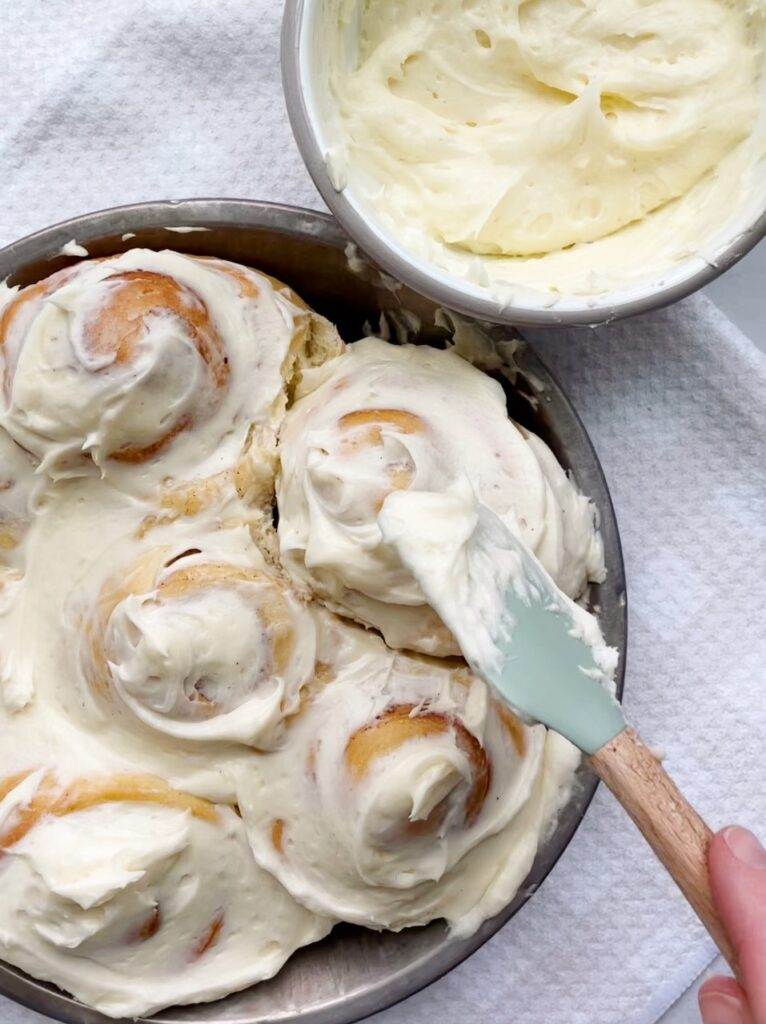
These are the very cinnamon rolls that I made for thousands of happy customers in my home bakery for more than ten years! If you’ve been looking for the best cinnamon rolls ever, look no further! They could be an incredible breakfast for a special occasion or one of the best desserts you’ll ever have!
These fluffy cinnamon rolls are also a long time family favorite! I’m confident they’ll become a family favorite for you too!
You can also use this dough recipe to make my popular Biscoff Cinnamon Rolls and Orange Sweet Rolls!
Learn from my step by step video
If you are a visual learner and need some extra help making cinnamon rolls or other yummy breads, I have virtual baking classes, including one for Cinnamon Rolls. My classes include a pre recorded video, showing you how to make the recipe from start to finish, including my extra professional tips! Classes are available anytime – making it easy to watch and make on your own schedule. You can find a list of my virtual classes HERE.
Why these are the perfect cinnamon rolls
- The dough is so easy to work with! Made with my Master Roll Dough – which can also be used for Crescent Dinner Rolls, Orange Rolls and so much more!
- They bake up so soft and fluffy!
- The cream cheese frosting creates the perfect sweet, creamy topping for a generous cinnamon sugar filling!
- Freeze unbaked, un risen cinnamon rolls to make later – the dough will stay good, frozen for up to 2 months!
How to bake with yeast
Working with yeast dough can be intimidating at first, but the more you do it, the more comfortable you will get! Yeast is a living organism that just needs the right conditions to thrive. It feeds off of sugar and starches. When it feeds, it releases carbon dioxide gas in the form of air bubbles in the dough. This process is also known as “fermentation”. This is what gives bread dough its volume and airy texture.
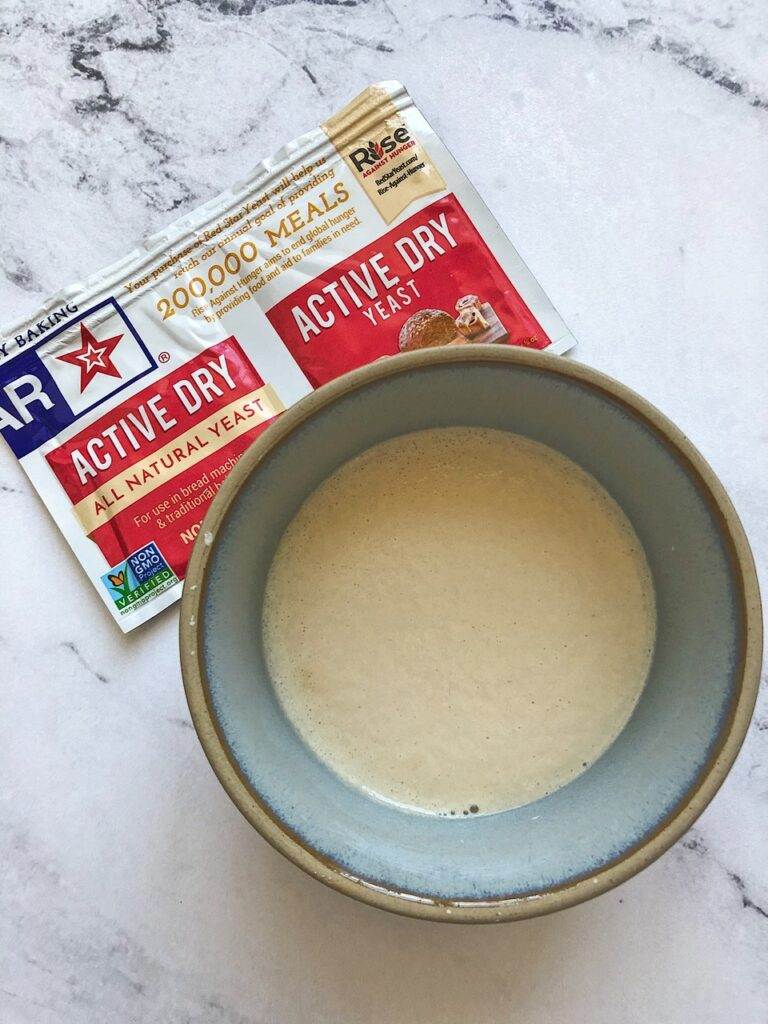
If you want more information about yeast, check out my article about Active Dry Yeast vs. Instant Yeast. I also have a Guide to making Sourdough Starter, which is how to make a natural yeast.
Ingredients
There are some unique ingredients in this recipe that makes it so delicious! Each serves an important role in how this dough and these cinnamon rolls will turn out. (If you’re looking for these ingredients, click on the ingredient name in bold – it will take you to an Amazon link you can purchase from).
- Bread flour: Most bread recipes will use bread flour. It has a higher protein content (11-13%) than an all-purpose flour. Higher protein flours also mean a higher gluten flour – yielding a bread with a strong crumb structure.
- Powdered milk: In baked goods it provides a creamier flavor and helps yield a more golden brown color when baked. Look for powdered milk that is fine in texture. If you are looking for a non dairy option, try using a milk powder substitute like coconut, soy or rice powder.
- Instant Yeast: It can be added directly to your recipe without having to proof first. It’s a strong, fast acting yeast that will allow these sweet rolls to rise super fluffy. I like to use BellaRise instant yeast or SAF instant yeast
- Eggs: Eggs in bread help to create a fluffy, big rise. They are perfect for these rolls, since it’s meant to be soft and fluffy.
- Potato Flakes: Potato flakes in bread make the crumb more moist and tender. The starches in the potato flakes also help the dough to retain its moisture, extending the shelf life of homemade bread. Some countries do not have potato flakes. You can substitute this with plain, boiled and mashed potatoes, cooled to room temperature. You could also swap out the potato flakes with equal parts potato flour.
- Butter Flavor Shortening: Vegetable shortening yields a roll that has a lighter, fluffier texture. The butter flavor gives it a more rich, butter flavor. If you can’t find the Butter Flavor Shortening, use plain shortening – it will still turn out amazing! If you prefer to not use shortening, replace it with more unsalted butter.
- Cinnamon and brown sugar mixture: mixing these together before sprinkling on top of the dough helps give a more even distribution for the filling.
- Cream Cheese Frosting compliments the slight spice from the cinnamon perfectly!
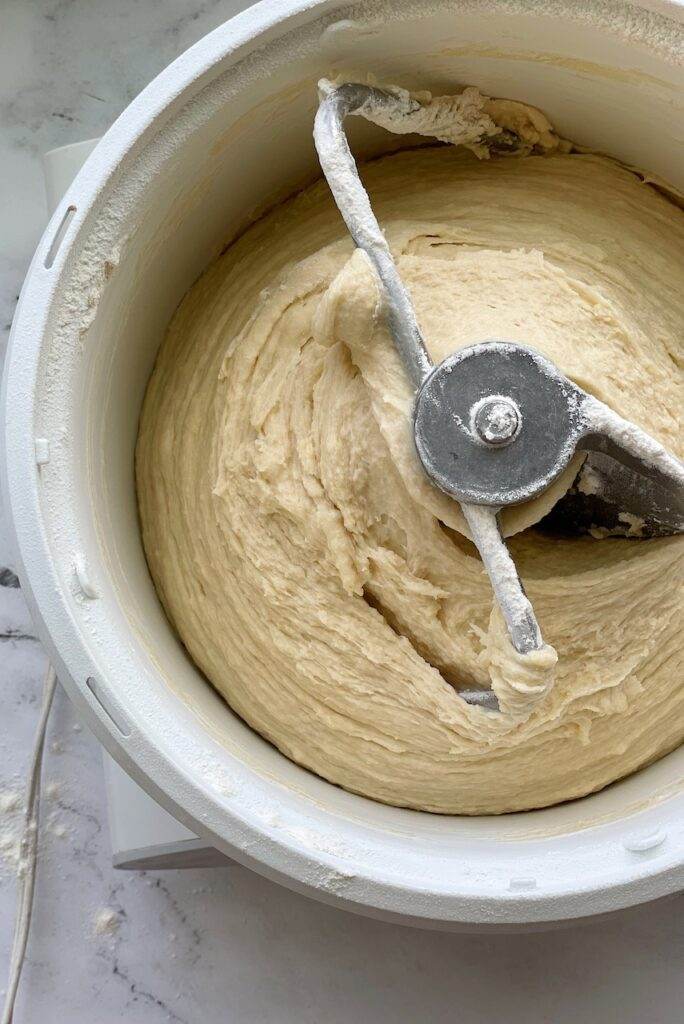
Equipment needed
- Stand mixer: You will need to use some type of a stand mixer to make this dough. You could mix it by hand, but it would be very challenging. There are two mixers I’ve used that I really love for bread dough. The Bosch Universal Plus mixer (click to purchase) is one I have used for years! It has a high mixing capacity and high performing motor – making it an excellent option for mixing denser doughs like bread. It also allows you to mix larger quantities. Another mixer I really love, (and I’ve actually been using this more than my Bosch lately), is the Ankarsrum (click here to purchase). It also has a high mixing capacity and smooth motor. I love that there is no center column to work around, the motor is smooth and quiet, and there is a timer with an automatic shutoff. *I will usually double this recipe if using my Ankarsum mixer. If you don’t have a high capacity mixer, the recipe I’m providing you with will fit nicely in a Kitchen Aid type stand mixer. Whichever mixer you use, be sure to use your dough hook attachment.
- Rolling pin
- Dough mat – not necessary but so helpful! I love using this silicone mat for so many baking projects. It makes it easier to roll out my doughs, using less flour. When you can use less flour, your bread turns out much better. It’s also easier to roll out and shape my dough using this mat. Easy cleanup too!
- Dental floss: Using dental floss to cut cinnamon rolls makes the cleanest cuts without smashing the roll! Wrap the floss around your index fingers (just as you would to floss your teeth). Slide the floss under the roll, bring the ends up and cross them over. Tug and cut the roll. You’ll love how easy it is and how efficiently this method works!
- Baking sheet: I prefer to bake these cinnamon rolls in a metal baking sheet, rather than a ceramic or glass casserole dish. Ceramic and glass dishes take longer to heat up – often you’ll get cinnamon rolls that are brown on the top and light or doughy on the bottom. Another great option for cinnamon rolls is foil pans. I especially love the ones that have a plastic dome lid for easy storage of leftovers!
Mixing the cinnamon roll dough
I love baking with this dough! It’s such a pillowy, soft dough that’s so easy to work with! I use it in several other recipes like Crescent Dinner Rolls, Orange Rolls and S’mores Sweet Rolls! You’ll see it is so easy to mix up and use.
- Measure out all of your ingredients ahead of time. I always do this when making a recipe – it helps to prevent me from making any mistakes in measurements or leaving out ingredients. It also makes the mixing process go much smoother. I always suggest weighing out your ingredients with a food scale – you will get much more accurate results!
- In a large bowl, combine the warm water, powdered milk, potato flakes, sugar, salt, yeast. Whisk them together – this helps to break up the powdered milk and potato flakes and gets all of those ingredients incorporated before adding the heavier ingredients. Pour the yeast mixture into the bowl of a stand mixer.
- Add the eggs, room temperature butter and shortening. Add 3 cups of the flour (about half) and mix on low, just until all of the ingredients are combined and smooth.
- While the mixer is on low, gradually add two cups of the remaining flour, 1/2 cup at a time, mixing well after each addition. This is where getting to know your dough comes into play. You’re looking for the dough to clean the sides of the bowl as it’s mixing. It should be concentrated around your dough hook. Once you get it to this point, stop the mixer and lightly tap on the dough with your finger. If it feels soft, but not wet and sticky & is cleaning the sides of the bowl, it’s ready to knead. Return to mixing it on low and allow your mixer to knead it for 5 minutes.
My number one tip for mixing this dough
Avoid the urge to add more flour. This dough is very soft and easy to work with – it’s very forgiving! You may see a little bit of dough sticking to the sides of the bowl when it’s kneading – don’t panic! Go by how it feels. You want to use just enough flour so that it doesn’t feel wet or excessively sticky. Too much flour in your dough will give you dry, dense rolls. You can always add a bit more flour after it has kneaded if it’s too sticky to work with.

Double Rise
Like most bread doughs, this roll dough will have a double rise – meaning you will let it rise twice. Remember, the process of “rising” is simply allowing the yeast to feed and create those magical air bubbles in the dough.
The first time the dough rises is right after the kneading is over, but before you divide and roll out the rolls. The first rise in bread making is called the “Bulk Fermentation”. It is vital to the development of your dough structure. It creates important volume and gluten development. You’ll see that after the bulk fermentation, your dough will be much easier to work with!
For the first dough rise, place the dough in a greased bowl and cover with a clean kitchen towel or plastic wrap. Put it in a draft-free place in your kitchen. The first rise typically takes about 60-90 minutes, depending on the ambient temperature of your kitchen. You want to keep your dough covered, in a warm place in your kitchen. You are looking for your dough to double in size.
The second rise happens after you have shaped the rolls and place them onto the pan. This is called “proofing”. The second rise will usually take about half of the first rise time. Your beautiful homemade cinnamon rolls will puff up to double in size at this point, usually taking about 45 minutes.
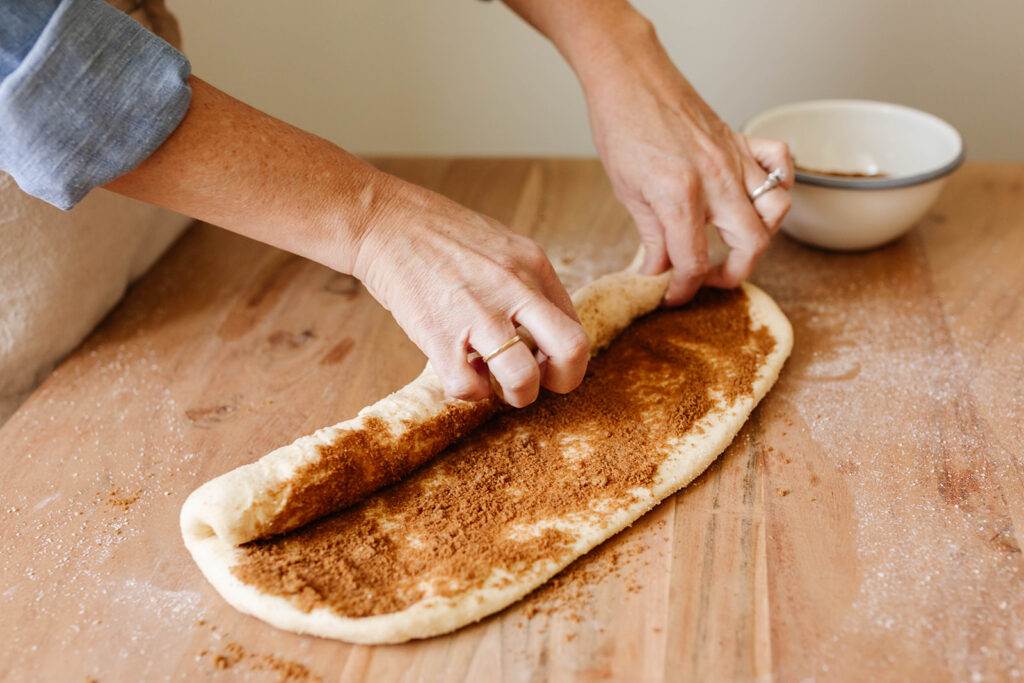
Rolling up your Cinnamon Rolls
Get your work space all ready with everything you need at your fingertips. You’ll need a small bowl with flour, a rolling pin, floss, melted butter and the cinnamon brown sugar mixture.
- Divide the dough into two equal pieces, about 28-30-ounce portions. If you don’t have a scale you can eyeball it. Round each portion to an oval shaped ball by pulling and tucking the dough under. This will make it easier to roll out into a rectangle.
- Flour your work surface and roll the dough out to a rectangular shape, about 10 inches by 18 inches and 1/4 inch thick.
- Spread the melted butter on the dough, leaving an inch border on the top side of the rectangle. Sprinkle about 1/4 – 1/3 cup of the filling mixture on top of the melted butter, continuing to leave the inch border at the top edge. Leaving this clean border will help in sealing the dough shut when rolled up.
- Start with the long side, closest to you and working from left to right begin to roll the dough up. You can tug and pull as you go which will tighten the roll and make more swirls.
- Once it’s all rolled up, pinch the seam shut.
- Using a piece of dental floss or bakers twine, make a light indentation where your cuts will be. Each of these roll outs will give you 9 cinnamon rolls. This will be your guide to know where to cut and to help make them all the same size.
- When ready to make your cuts, slide the floss under one end of the dough, bring the ends of the floss up, cross them over and tug to cut through the dough to make a 2-inch-wide cinnamon roll. Continue to cut to get 9 equal sized rolls.
- Place rolls on a baking sheet sprayed with cooking spray or lined with parchment, about 1-2 inches apart. Cover with a clean kitchen towel for about 45 – 60 minutes, or until they double in size.
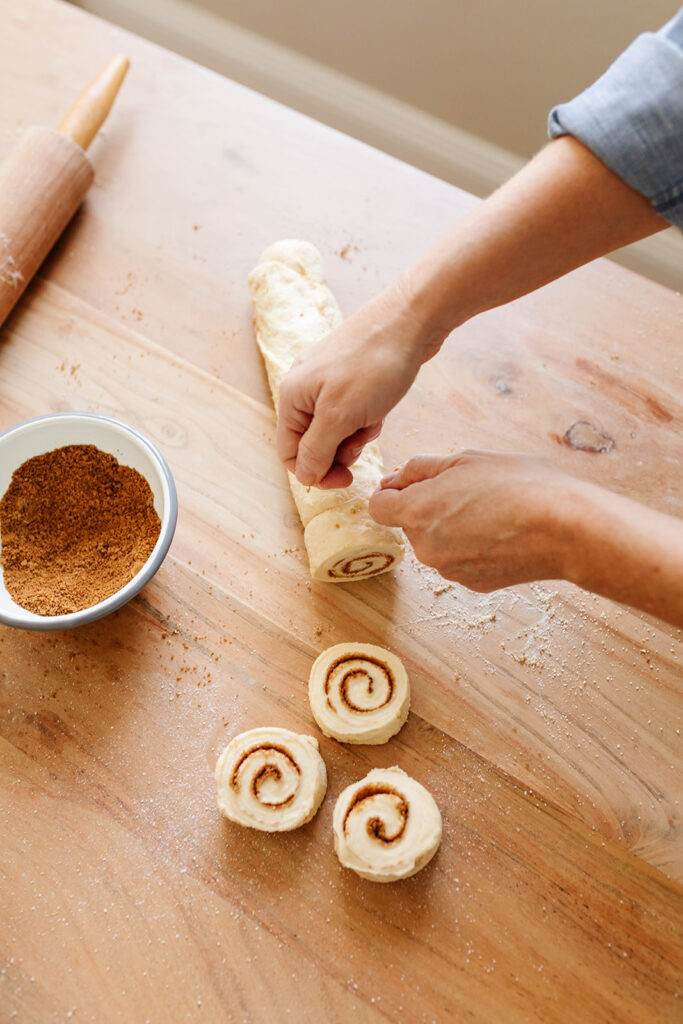
Baking Cinnamon Rolls
Be sure to allow them to rise and double in size. Bake them until the edges are slightly golden. I fully believe that an oven thermometer makes you a better baker! Each oven bakes differently and using an oven thermometer like this one will help make baking so much easier for you!
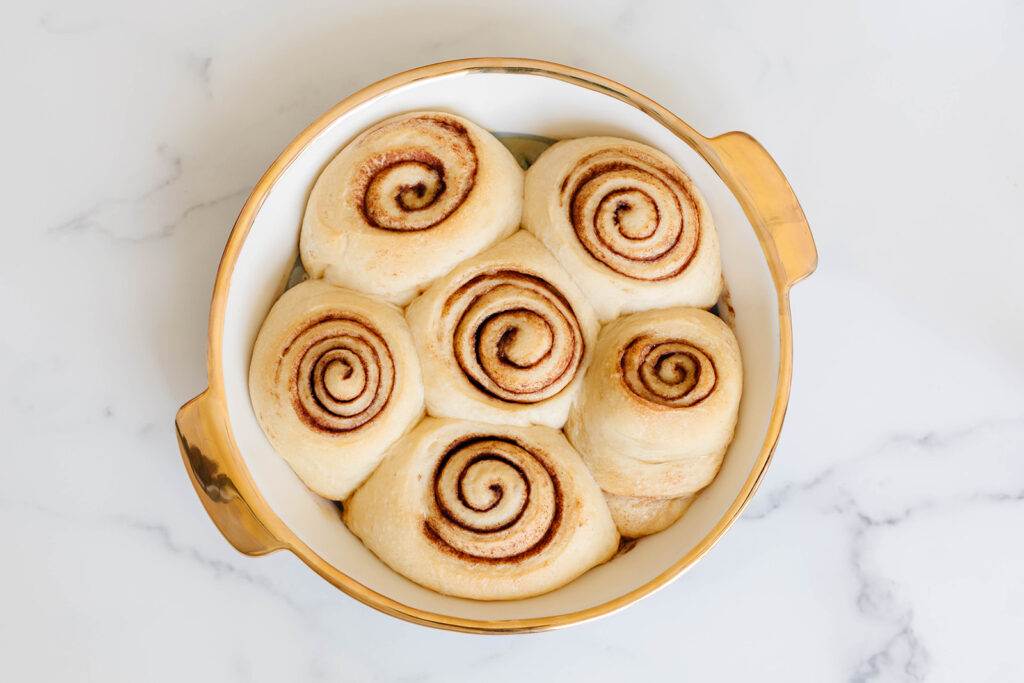
Follow up with most amazing cream cheese icing! If you want your icing to be more runny, frost the cinnamon rolls while they are still warm – this will melt the frosting and it will run into all the delicious cracks and crevices of the warm rolls! This is especially delicious with my Brown Butter Cream Cheese Frosting recipe!
If you like your icing more of a frosted, whipped texture, wait until the cinnamon rolls have completely cooled to frost them. Either way you top them, these cinnamon rolls are so fluffy and delicious!
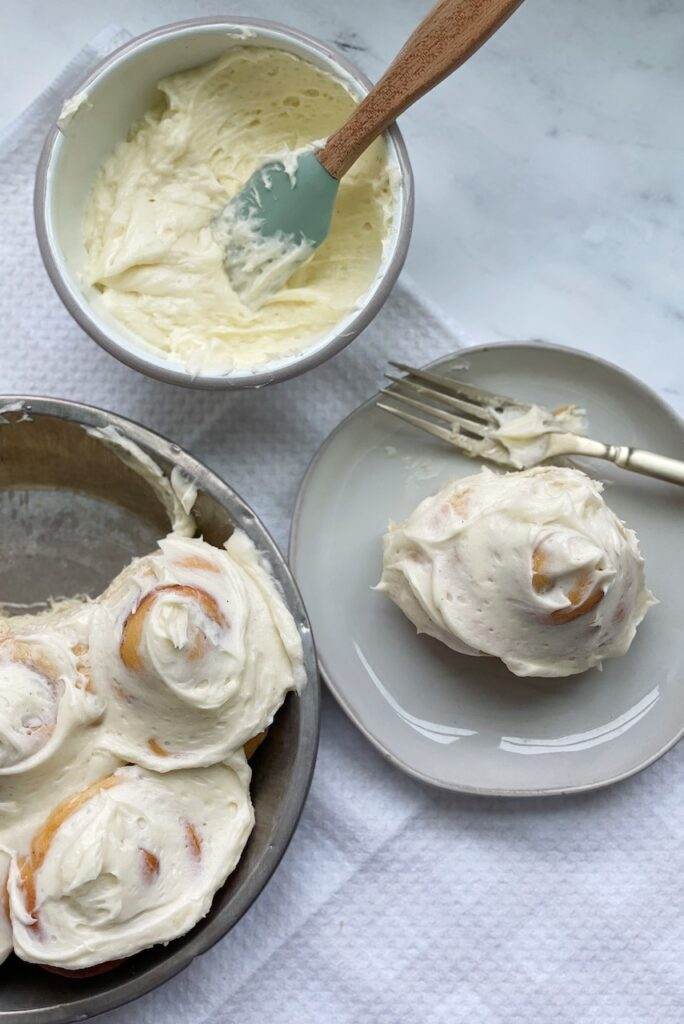
Time Saving Tips
Here are a few ways you can prepare ahead of time so that you can have freshly baked cinnamon rolls without having to start from the very beginning!
- You can freeze rolls to bake for later: After rolling up and placing the rolls on a nonstick cookie sheet, put the entire pan in the freezer and allow the rolls to freeze for 24 hours. Once frozen, remove the sheet pan and you can pop them off, place them in a ziplock bag, and store in the freezer for later use. When baking frozen rolls, remove them from the freezer bag and place on a baking sheet. Allow them to rise at room temperature and bake as usual. This could take 3-5 hours, depending on how warm your kitchen is. You could also let them thaw on a baking sheet in the refrigerator overnight – plan on this taking about 12 hours. Remove them from the refrigerator and let them sit at room temperature for about 30 minutes while you preheat your oven.
- Make overnight cinnamon rolls: Roll out your cinnamon rolls in the evening, place on your pan and lightly cover with plastic wrap. Place them in the refrigerator. Allow them to proof in the refrigerator overnight and bake them the next morning! Overnight cinnamon rolls are a great way to enjoy them freshly baked without all of the work! Allow them to sit on the counter for about 30 minutes while you preheat your oven. It’s important to keep an eye on them – they ideally should not be in the refrigerator for more than 8-10 hours, or they may over proof.
- Make the dough the night before and roll up in the morning: Make the dough the night before and refrigerate: This can be a better option than rolling them up the night before IF your overnight cinnamon rolls tend to over proof. After you finish rolling them up, they will rise within 45 minutes and be ready to bake and frost!
Troubleshooting
Here are a few things that I’ve helped people with when problems arise in baking their cinnamon rolls:
- There is cinnamon liquid oozing out of the rolls when they are rising: This is a result of the dough rising. When they bake, you’ll see that the filling that oozes out of the bottom will bake into the cinnamon rolls. It’s nothing to worry about! But you could also try making a paste with your filling – instead of using melted butter, use softened butter and combine it with the cinnamon sugar mixture until a soft paste forms. Spread it over the dough and roll up as directed.
- The center of the cinnamon rolls exploded out of the roll when baked: This is most likely because you have too much dough in your pan. Try putting less cinnamon rolls in your pan and give the rolls more room to expand.
- The cinnamon rolls deflated after baked: When dough has over proofed, it loses its structure. Letting your cinnamon roll rise really big isn’t always a good thing. For the best results, be sure to only let them rise to double in size. If you are unsure if they are ready to bake, gently poke the side of a cinnamon roll with your finger. If the the indentation springs back immediately, it needs more time to rise. If the indentation stays and never springs back, you have over proofed the dough. If the indentation stays and springs back slowly, it’s ready to bake.
Store your cinnamon rolls in an airtight container or cover with foil to keep them from drying out. They will stay fresh for up to three days. I really like to bake them in foil pans that have the plastic lids that snap on tightly. You can bake and store them in the same pan! Plus, it makes it easier to share your cinnamon rolls without having to get your pan back!
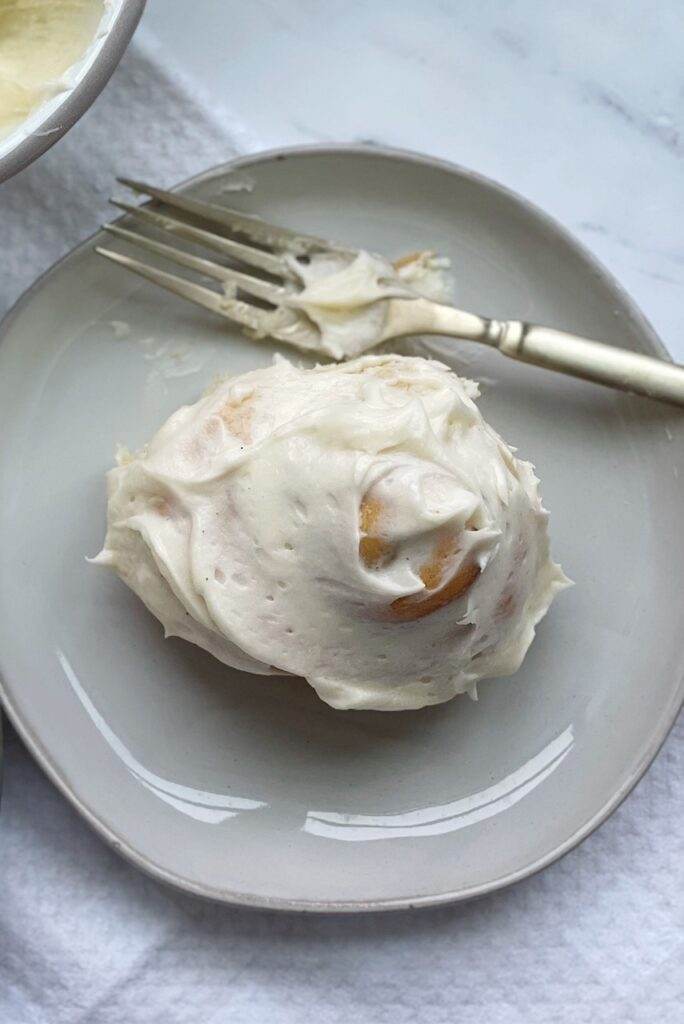
You’ll love making these yummy and easy cinnamon rolls! Try this recipe today! Be sure to post your results on Instagram and tag me! @thatbreadlady and #thatbreadlady. I love seeing how your family is enjoying my recipes!
(This post contains affiliate links. I receive commissions on products purchased from these links.)
More recipes to try!
If you like my Homemade Cinnamon Rolls, you’ll love these recipes too!
Brown Butter Cream Cheese Frosting
Christmas Morning Cinnamon Roll Wreath
Christmas Sugar Cookies with Buttercream Frosting
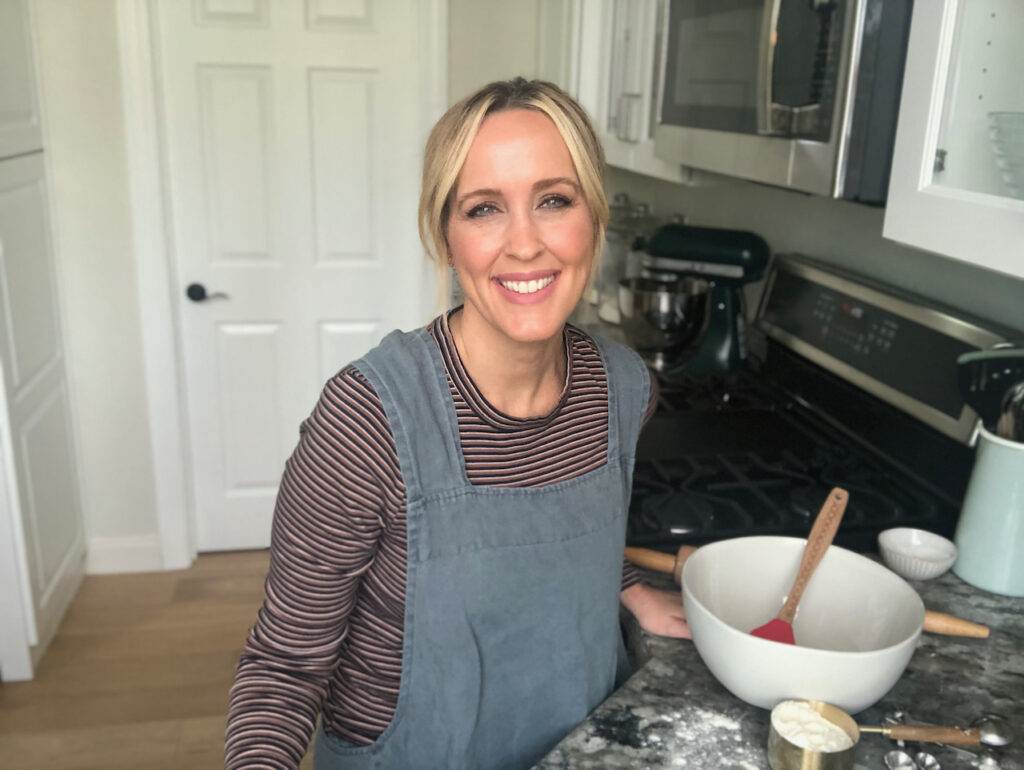
Get access to ALL of my virtual baking classes for one price!
If you are new to bread making, or just looking to improve your baking skills, be sure to check out my Baking Academy! You will get access to ALL of my virtual baking classes for one low price! Get all of my pre-recorded videos, showing you how to complete a recipe from start to finish! Included in my Class Library is Cinnamon Rolls so if this recipe seems a bit daunting, my video will help you to make these yummy rolls successfully!
You can go HERE to learn all about it!
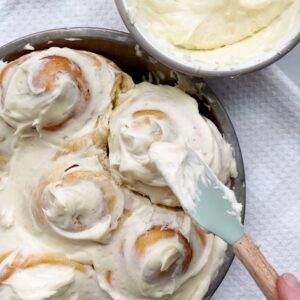
Homemade Cinnamon Rolls
Ingredients
Dough Ingredients:
- 2 cups warm water (about 115°F)
- ¼ cup nonfat powdered milk
- ½ cup boxed potato flakes
- ½ cup granulated sugar
- 1 Tablespoon plus 1 teaspoon instant yeast*
- 1 ½ teaspoons salt
- ¼ cup unsalted butter softened to room temperature
- ½ cup butter flavored shortening
- 2 large eggs
- 5-6 cups bread flour
Filling Ingredients:
- ¼ cup salted butter melted
- ¾ cups dark brown sugar
- 4 Tablespoons ground cinnamon
- Cream Cheese Frosting see notes
Instructions
Prepare the dough.
- In a large bowl, combine warm water, powdered milk, potato flakes, sugar, yeast and salt. Mix well with a wire whisk. Pour into the mixer bowl and secure the dough hook attachment to your mixer.
- Add the butter, butter flavored shortening and eggs. Add 3 cups of the bread flour. Mix for about 30 seconds until ingredients are incorporated. Stop the mixer and scrape down sides of bowl with a spatula.
- Turn mixer on low and add 2 more cups of the bread flour, 1/2 cup at a time. After adding the 2 cups of flour, let dough continue to mix for about 1 minute. Stop and scrape the sides of the bowl as needed. If dough is not mostly cleaning sides of the bowl, add more flour 1/4 cup at a time until it cleans the sides of the bowl. Stop the mixer and check the dough by gently pressing your finger into it. If the dough does not stick to your finger, it should be ready to knead. *When in doubt, it’s always best to go lighter on the flour. You can always add more flour, but you can’t take flour away. Too much flour in your dough will give you dry, dense rolls.
- Knead on low speed for 5 minutes.
- Remove dough from mixer and place in a greased bowl. Cover with a clean kitchen towel and let rise until doubled in size, about 60-90 minutes.
Prepare the filling.
- Melt ¼ cup salted butter in microwave safe dish and set aside.
- In separate bowl combine the brown sugar and cinnamon.
It’s time to roll.
- Divide dough into two 28-30-ounce portions. If you don’t have a scale, you can eyeball it. Round each portion to an oval shaped piece of dough by pulling and tucking it under. This will make it easier to roll out into a rectangle.
- Flour your work surface and roll dough out to a rectangular shape, about 10 inches by 18 inches.
- Spread half of the melted butter on the dough, leaving an inch border on the top side of the rectangle. Sprinkle about 1/4 – 1/3 cup of brown sugar on top of the melted butter, continuing to leave the inch border at the top edge. Leaving this border will help in sealing the dough shut when rolled up.
- Start with the long side closest to you, and working from left to right begin to roll dough up. You can tug and pull as you go which will tighten the roll and make more swirls.
- Once it’s all rolled up, pinch the seam shut.
- Using a piece of dental floss or baker’s twine, make a light indentation where your cuts will be. One rollout will give you 9 large cinnamon rolls. This will be your guide to know where to cut and to help make them all the same size.
- When ready to make your cuts, slide the floss under one end of the dough, bring the ends of the floss up, cross them over and tug to cut through the dough to make a 2-inch-wide roll. Continue to cut to get 9 equal sized cinnamon rolls. Repeat steps 2-7 with the second piece of dough.
- Place cinnamon rolls on a greased or parchment lined baking sheet about 1-2 inches apart. Cover with clean kitchen towel and let proof for about 45-60 minutes, or until they double in size.
Bake.
- Bake in a preheated 350°F oven for 16-20 minutes or until edges are just golden brown. Allow to cool before frosting.
- Frost with my Cream Cheese Frosting.
Notes
- Find my cream cheese frosting recipe at: https://thatbreadlady.com/cream-cheese-frosting/
- For a delicious Caramel Cinnamon Roll option, try using the filling and frosting from my Pumpkin Biscoff Cinnamon Rolls. The result gives such an amazingly rich and caramel flavor! It’s out of this world! *Be sure to frost the cinnamon rolls right after they come out of the oven. This will allow the brown butter frosting to melt into all of the cracks and crevices!
- *You can replace the instant yeast with active dry yeast – be sure to proof it first. Proof it by adding the active dry yeast to the water with 1 Tablespoon of the sugar. Let it sit for up to 10 minutes to foam up. If it doesn’t foam, replace yeast with a fresh package.
- You can bake directly in the pan, without parchment paper. Be sure to spray your pan with nonstick spray.
- You can freeze the cinnamon rolls to bake later. After rolling up and placing the rolls on a nonstick cookie sheet, put the entire pan in the freezer and allow the rolls to freeze for 24 hours. Once frozen, remove the sheet pan and you can pop them off, place them in a ziplock bag, and store in the freezer for later use. When baking frozen rolls, remove them from the freezer bag and place on a baking sheet. Allow them to rise at room temperature and bake as usual. This could take 3-5 hours, depending on how warm your kitchen is. You could also let them thaw on a baking sheet in the refrigerator overnight – plan on this taking about 12 hours. Remove them from the refrigerator and let them sit at room temperature for about 30 minutes while you preheat your oven.
- Make overnight cinnamon rolls by letting them proof in the refrigerator overnight. Let them sit on the counter for about 30 minutes to come to room temperature while the oven preheats. However, if your overnight cinnamon rolls tend to get too big in the refrigerator, you can make the dough the night before and refrigerate – roll them up in the morning and let rise to double in size, about 45 minutes before baking.
- This dough is the same base dough for my Crescent Dinner Rolls. It can also be used for various sweet rolls by switching up the filling and the frosting. It’s called my “Master Roll Dough” on my blog.
- To make mini cinnamon rolls, divide dough into one third the regular weight/size and roll out as directed. For example, instead of rolling out a 25-27oz dough ball, roll out a 8-9oz dough ball, but divide it into nine cinnamon rolls. This will give you the mini size. Roll the dough out more long and narrow than the regular sized cinnamon rolls. Rise time may be slightly less. Decrease bake time by 2 minutes.

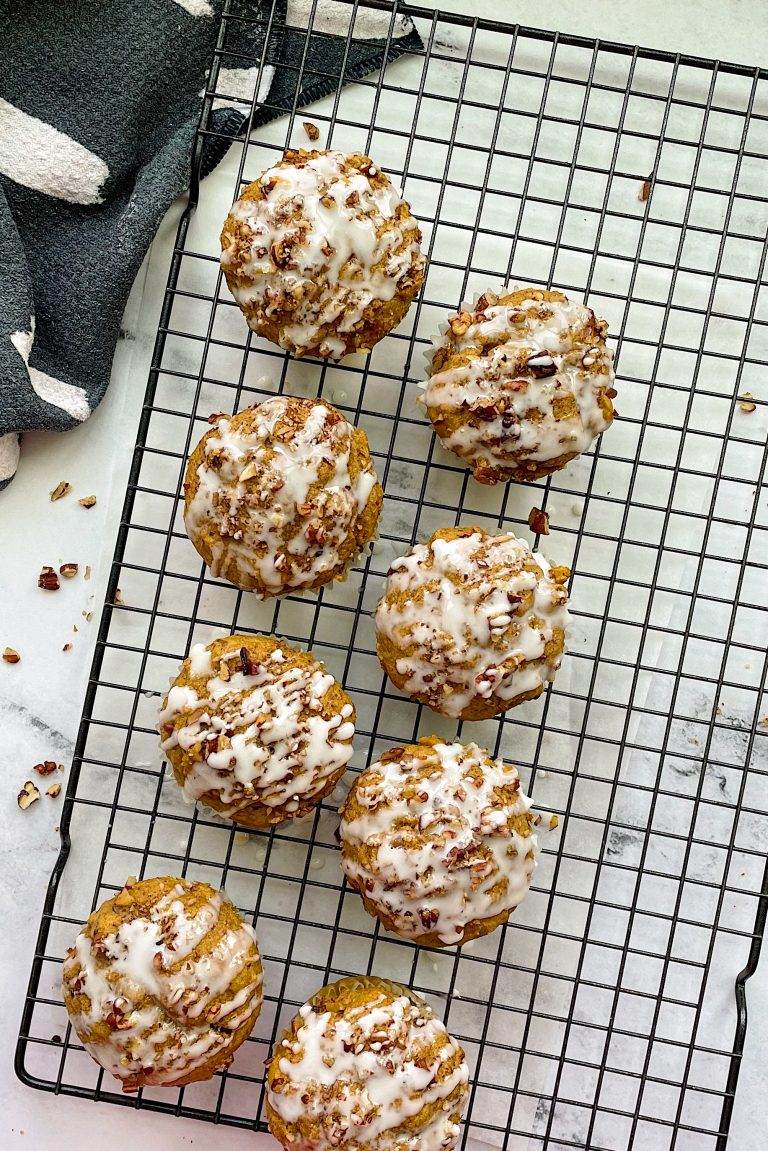
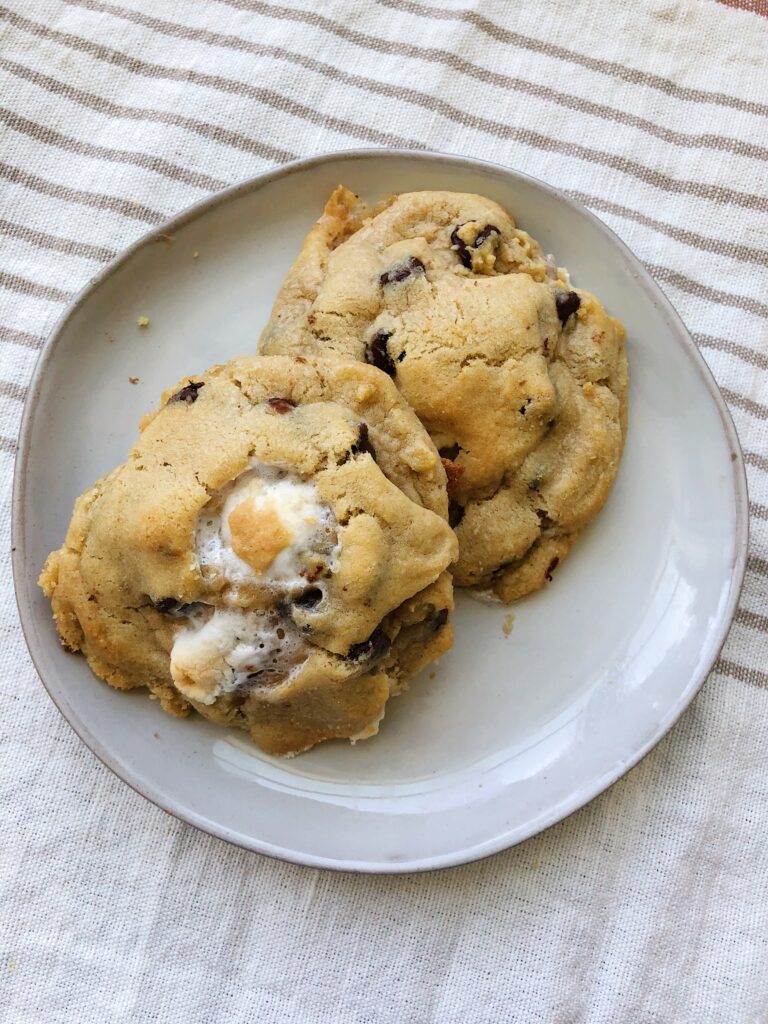
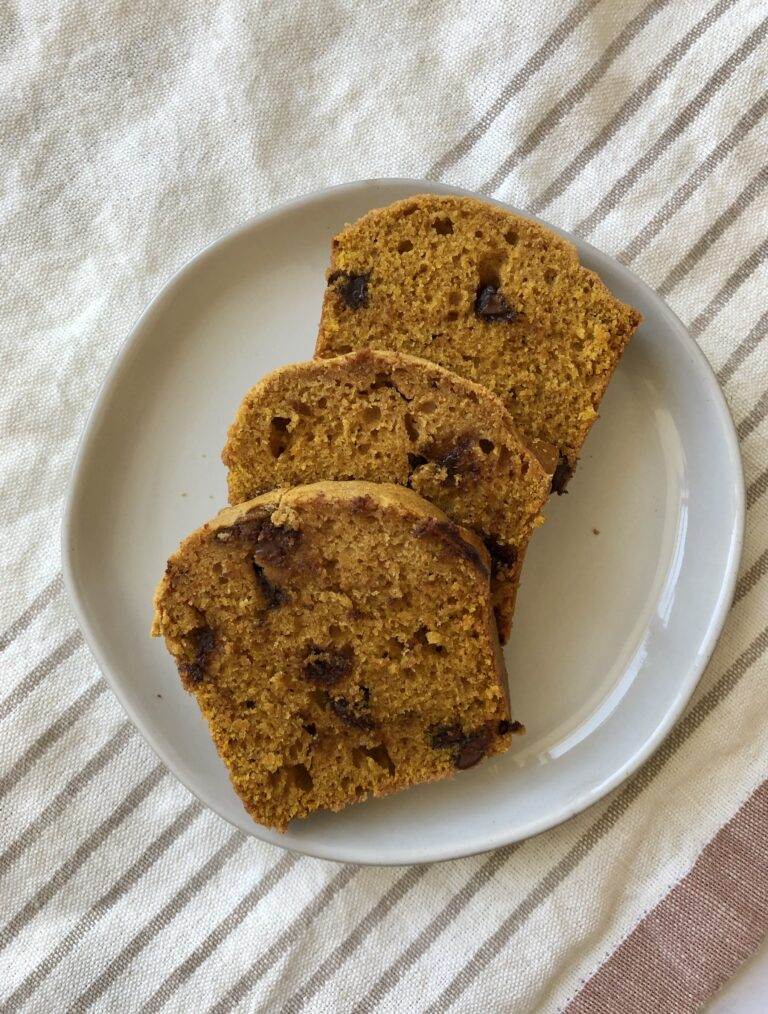
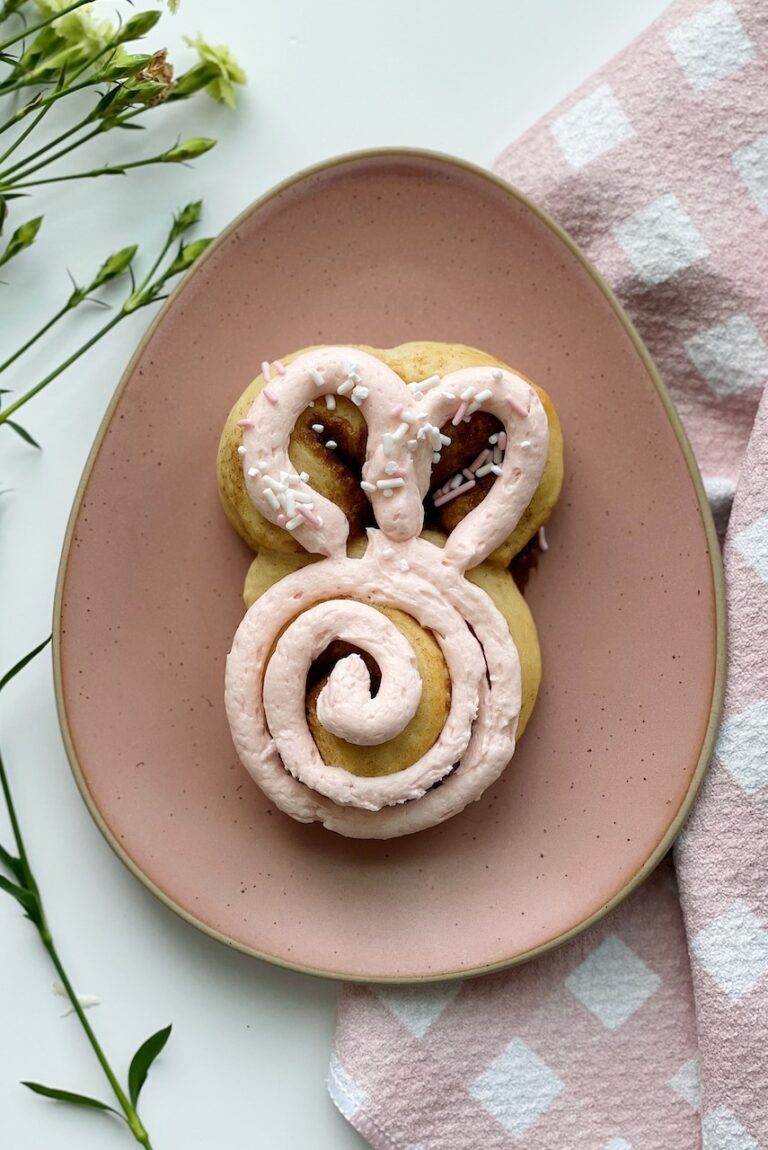
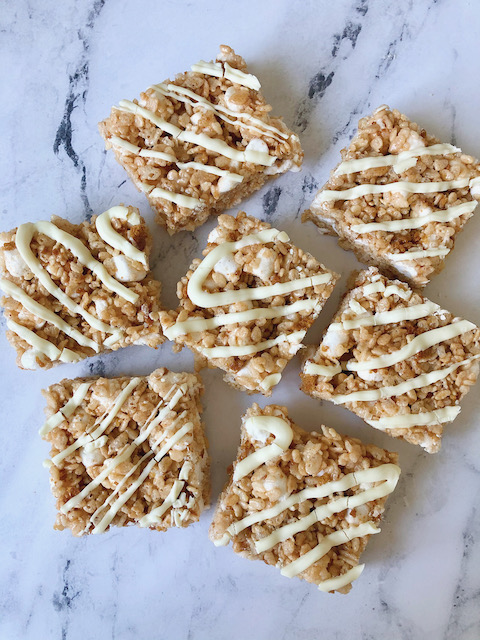
These look amazing bit unfortunately we don’t have potto floes or shortening in Australia. Is there anything I can substitute those ingredients with)
Hi Bev,
Try subbing the potato flakes with real, boiled, riced and cooled potato. You really just want something that can provide the starch and flavor from the potato. Potato flakes are also known as Instant Potatoes or boxed potatoes. For the butter flavored shortening, try replacing it with more butter. Let me know if you try either of these substitutions and how it turns out!
Help me out with the butter flavored shortening thing. . . If I don’t have buttered flavor shortening, would I just use all butter- 3/4 cup butter or would you use 1/2 cup butter and 1/4 cup shortening?
Hi Mollie! So if you don’t have butter flavored shortening, I’d use regular shortening instead. If you don’t have that, I’d replace that with butter. BUT the buttered flavor shortening really gives the best results! I know that’s not available everywhere so hopefully these other options help!
I Have been making cinnamon rolls for almost 50 years.. I did like your dough! it was very nice but I do not like the dark Brown sugar and that is too much cinnamon.. I use 2 tablespoons of cinnamon.. it’s just perfect.❤️
So glad you liked the rolls Linda! I do like a good cinnamon flavor…but, everyone has their own preference. I’m glad you found a good balance for what you like! Thanks for giving it a try!
@thebreadlady I’m so excited to make these cinnamon rolls. Will you please provide the exact brand name of the powder milk, potato flakes and bread flour you use when making these cinnamon rolls?
Also, please provide link to where I can purchase the Bosch universal plus mixer and BellaRise and SAF instant yeast. Thanking you in advance! Jay
Hi Jay! Please click on the ingredients for the links. If they are in bold, they usually have a link you can click on. Same for the Bosch mixer. Although, I have just updated my post…I have recently started using an Ankarsrum and I love it! Bosch is really great too! LEt me know if you have any questions about the two so I can help you purchase what works best for your needs!
I am so excited to try this recipe! I have been trying out different cinnamon roll recipes and none of them come out to my liking…
My only question is, if I wanted to make these with sourdough discard would I be able to add that in easily or will it tweak the rest of the recipe to fit it in?
(Hopefully that makes some sense)
Can you use gluten free flour?
I haven’t tried this recipe with gluten free flour. Let me know if you try it!
Oh my! Love this recipe so much! Made the dough and after splitting, I did half of the recipe as crescent rolls for Christmas eve dinner and the other half made the most delicious cinnamon rolls for Christmas morning. Thank you so much for sharing with easy tips and great pictures for even a beginner to feel successful!
So glad you found success! Keep up the baking!
Why such a large disparity in the min and max amount of flour?
Going by touch for this dough is key. There are many factors that can affect your dough, like humidity and flour type. Adding too much flour can result in dry rolls – for this reason, I encourage you to add just enough so that the dough is soft, but not sticking to your fingers. Since this amount can vary, I give you a range of how much flour that could possibly be for you. Hope this helps.
Experienced baker here and the recipe multiplier does NOT work! Be Warned. When doing 2x or 3x the math in grams is incorrect. Had to recalculate the mistakes in the recipe multiple times.
Thank you for letting me know Tony! I’ll take a look and get that fixed.
When baking breads, what is the best substitute for eggs (I’m allergic)? I typically gear towards unsweetened applesauce or egg replacer (mixture of baking soda and tapioca and potato starches). Applesauce can make the mixture too moist so I’m guessing egg replacer is the way to go from my experience, but I was wondering if you agreed or knew of a better substitution.
Also when replacing the shortening fully with butter, is it a 1:1?
Thanks for your expert insight!
I don’t have much experience with replacing eggs, but I’m thinking an egg replacer might work best. I’ve also read that aquafaba (the liquid from canned chick peas) works well in many baked goods, including breads.